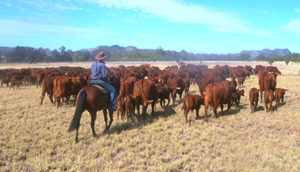Read the latest information on
Foot-and-mouth disease

A number of detections of cattle tick Rhipicephalus (Boophilus) in tick-free zones have prompted Animal Health Australia to promote proactive biosecurity process and due diligence when buying or selling livestock.
Cattle ticks are endemic across much of northern Australia, and can survive along the east coast as far south as parts of New South Wales. A tick fever case was detected on the NSW Mid North Coast in May 2018.
Cattle ticks are external parasites which feed on their hosts, impacting gains and milk production. It is estimated that cattle ticks cost cattle industries $140 million annually in production, prevention and treatment costs. Heavy infestation can lead to loss of condition and sometimes death. Cattle ticks can also transmit a number of blood-borne illnesses, resulting in illness and death. The most common is tick fever which can cause devastating losses in unvaccinated cattle.
“Naïve herds, or cattle which have never been vaccinated for tick fever or exposed to ticks previously, are most at risk from tick-borne diseases,” Dr Humphrys, AHA’s Executive Manager of Biosecurity and Product Integrity, explained.
“Each state and territory in the tick-susceptible area has control mechanisms in place to prevent the spread of cattle ticks and protect naïve stock. It is the responsibility of everybody that travels livestock, even as pets, to meet the requirements under these control programs before moving livestock.”
High-risk hosts, including cattle, buffalo and deer, are subject to the strictest controls, often including a need for chemical treatments and certification by an inspector or accredited certifier to move into the free zone. However other hosts, such as horses, sheep, goats, and camelids may also be subject to restrictions or require management to move.
“It’s vital that you’re aware of which side of the line you are on and treat stock accordingly before moving them,” Dr Humphrys said.
“It’s also important to ensure that if you’re buying stock from the infested/infected zone to bring into the free zone that you’re receiving certified tick-free stock from a trusted supplier.”
Simple biosecurity practices can also help manage cattle ticks. Visually inspecting both the paperwork and the livestock before they are unloaded may prevent you from unloading ticky livestock on to your property. Cattle ticks are a ‘one host’ tick, meaning they go through their life cycle on the animal, only dropping off to lay eggs on the ground. Their life cycle depends on the species they have attached to and the environment they are in ranging from 18-35 days.
Similar inspections can take place when you are yarding or transporting livestock off your property as livestock are moving through yards. Cattle tick infestations present as bumps on the skin, particularly in inspection sites which include the butt of the tail, escutcheon, ears, flank and dewlap. The bumps are caused when the ticks attach to feed, but you will likely be able to see older stages of cattle ticks (i.e. young adults) just by looking at livestock in these areas.
Isolating new stock for 7-21 days in a yard or smaller holding paddock enables you to monitor them for emerging health issues and treat accordingly, without exposing your existing stock. Maintaining fencing also goes a long way to preventing spread of cattle tick, by preventing wandering stock dropping ticks in new paddocks and spreading to other livestock or neighbouring properties.
If you apply a chemical to livestock to manage cattle ticks be sure to record the details on an animal health declaration if the animals are being offered for sale and supply that declaration to the buyer. Ensuring that you are responsibly using chemicals reduces the risk of cattle ticks becoming resistant to chemicals, which can happen by not using the correct application rate or applying a chemical again when they are still within a re-treatment interval.
“Biosecurity is everybody’s responsibility and having good biosecurity practices in place on farm ensures you will prevent or minimise an outbreak of cattle ticks. Cattle ticks found in the free zones are notifiable, meaning their detection must be reported to the relevant authority,” Dr Humphrys said.
For more information on managing biosecurity for cattle, visit the Beef and Dairy pages on the Farm Biosecurity website.